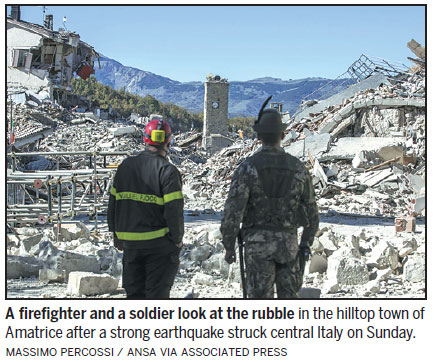PM: Quake strikes at 'nation's identity'
The third powerful earthquake to hit Italy in two months spared human life on Sunday but struck at the nation's identity, destroying a Benedictine cathedral, a medieval tower and other beloved landmarks that had survived the earlier jolts across a mountainous region of small historic towns.
Lost or severely damaged in the shaking were ancient Roman walls, Gothic and Baroque churches and centuries-old paintings crushed beneath tons of brick, sandstone and marble.
Italian Prime Minister Matteo Renzi said the nation's "soul is disturbed" by the series of quakes, starting with the deadly Aug 24 event that killed nearly 300 people, two back-to-back temblors on Oct 26, and the biggest of them all, a 6.6-magnitude quake that shook people out of bed on Sunday morning. It was the strongest quake to hit Italy in 36 years.

There were no reports of fatalities a fact attributed to the evacuation of sensitive areas and fragile city centers. Nearly 8,000 people have been moved to shelters or hotels following the quakes last week and Sunday, and Italy's Civil Protection agency was expecting that number to reach 11,000 on Monday. Many who stayed behind were sleeping in campers or other vehicles, out of harm's way.
Renzi vowed to rebuild houses, churches and business, saying, "a piece of Italian identity is at stake at this moment".
"Feeling the earth collapse beneath your feet is not a metaphorical expression but is what happened this morning, and half of Italy felt this," Renzi said.
The quake struck another painful blow to the rich artistic heritage of villages that dot the Apennine Mountains.
Worst damage
The worst damage was reported in Norcia, a town in Umbria closest to the epicenter. Two churches were destroyed the 14th century Basilica of St. Benedict, built on the traditional birthplace of St. Benedict, founder of the Benedictine monastic order; and the Cathedral of St. Mary Argentea, known for its 15th century frescoes. Only the cracked facades were still standing, with most of the structures disintegrating into piles of rubble and dust.
Television images showed nuns rushing into the main piazza as the bell tower appeared on the verge of collapse. Later, nuns and monks knelt in prayer in the piazza. A firefighter appealed to a priest to help keep residents calm in an effort to prevent them from looking for loved ones.
When the quake stuck, nuns from the Saint Mary of Peace monastery in Norcia were praying and singing hymns. The shaking caused their building to collapse and badly damaged their sleeping quarters. Later, firefighters escorted them back inside to retrieve holy books. Then an aftershock hit.
The quake was felt as far north as Salzburg, Austria, and all the way down the Italian peninsula to the Puglia region, the heel of the boot. In Rome, some 150 kilometers away, people rushed into the streets in pajamas.
AP - Reuters


















